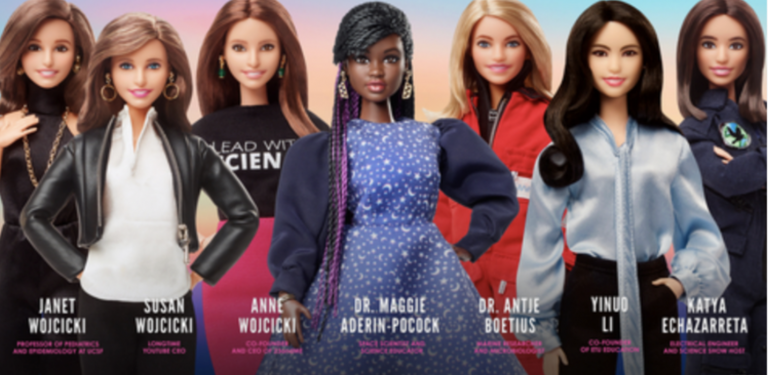Have you seen Barbie yet? Only three weeks into its release run, it’s already passed $1B at the box office. Its smashing success seems to have taken almost everyone by surprise – with the notable exception of star and producer Margot Robbie, who shared that she predicted the $1B milestone in a studio meeting. Only 53 movies have ever hit this milestone, and this is the only one directed by a woman.
So, what can science communicators learn from Barbie?
The first and most important takeaway – don’t skip on the marketing. From the Malibu Dreamhouse on Airbnb (now the Mojo Dojo Casa House!) to clothes, cosmetics, candy and even cruises, clever and consistent marketing was instrumental to breaking a Barbillion. The extensive campaign began a year before the release and famously cost as much as the movie itself – clearly proving its worth. Imagine if Barbie had been released without context: how many people would have been excited to see a movie about a doll, or would have thought it was only for children or girls? By engaging with your audience, you can spark interest in new segments, initiate new conversations, and most importantly, help people understand what you have to offer.

Another marketing masterstroke? Lean into viral moments. From creating custom filters to hopping on the #Barbenheimer train, the Barbie team made social media work for them. Even the marketing itself became a meme. STEM has no shortage of its own viral moments, from room-temperature superconductors to ChatGPT’s massive success to the first-ever image of a black hole. With a simple meme or tweet at the right moment, savvy scientists and communicators can use these moments to reach broad audiences and generate a buzz. It doesn’t have to be as extensive as Barbie: This mic-drop meme about a paper on lk-99 from a Berkeley scientist received 6.1M views. Not bad for a gif, a link to an ArXiv paper and a hashtag!

Finally, be creative. Barbie’s marketing drew on the classics but also challenged conventions. One of its first trailers was set to music from 2001: A Space Odyssey. There’s a Barbie XBox console, and you can drive Barbie and Ken’s cars in recent smash game release Forza Horizon 5. The team bucked the idea that Barbie is just for girls – netting audiences that might not have been interested otherwise. But just as crucially, Barbie’s marketing did specifically target women and girls – which is still widely believed to be bad for business, despite evidence to the contrary. And its box office success shows that the old studio saying, that “women will watch films about men but not the reverse” is not as true as one might believe. Finding creative, inclusive ways to challenge conventional wisdom about your audience and their interests can have a huge payoff.
Inspiring me this week… Dr Maggie Aderin-Pocock
On the topic of Barbie, did you see the STEM Barbies released for International Women’s Day this year? I love how many interests, nationalities and careers are represented. Alongside the three Wojcicki sisters (now there’s an impressive family) the group includes marine researcher and microbiologist Dr. Antje Boetius; founder of ETU Education Yinuo Li; electrical engineer Katya Echazarreta; and Dr. Maggie Aderin-Pocock, space scientist and presenter.
I was particularly inspired by Dr Aderin-Pocock’s work in science communication for adults and children. Alongside her rather impressive resume – which includes work on the James Webb telescope; spectrography for the Gemini Observatory in Chile; and a recent appointment to Chancellor of the University of Leicester – she finds time to co-host of BBC’s The Sky at Night and children’s science programme Stargazing.
Not only is she a leading science communicator, but she overcame undiagnosed dyslexia and bias – including a teacher advising her to become a nurse rather than an astronaut – in order to do so. Celebrating her Barbie model, she said: “I want to inspire the next generation of scientists, and especially girls, and let them know that STEM is for them. When I was little, Barbie didn’t look like me, so to have one created in my likeness is mind-boggling. It’s such an honour to receive this doll that is celebrating my achievements.”
We’re obsessed with… Sun Bears
Speaking of memes, I’ve been loving the hilarious conversation around the sun bear that sparked a global sensation when a video of its suspiciously human-like appearance went viral. My favourite has to be the Betoota Advocate:

Huanghzou Zoo itself leaned into the fun – and have seen visitors skyrocket as a result. Their statement, “written by” Angela the sun bear herself, took a moment to educate the public: “Some people think I stand like a person… It seems you don’t understand me very well … We Malayan bears are petite, the smallest bear in the world.” This UK wildlife park also cleverly took a moment to weigh in with a video of their own sun bear, which is definitely not a guy in a bear suit. I think.
More beary important news that caught my eye:
- Around the world, sun bears are having a moment – and conservationists jumping into the conversation to spread the word about this critically endangered species
- Moving on from the world’s smallest bear, 500-lb Hank the Tank, a criminal mastermind behind 21 home break-ins in California’s Lake Tahoe, has been apprehended (and will be released in Colorado)
- Up in Alaska, enjoy this live-cam of bears fishing at Brooks Falls in Katmai National Park
- And finally, an intrepid bear from Baghdad escaped a flight while on layover in Dubai
Written by: Kylie Ahern, Publisher of The Brilliant and CEO of STEM Matters


Comments are closed.